Chest Binding
What is chest binding?
'Chest binding' or 'binding' is the compression of chest tissue to achieve a flatter chest. Binding is commonly used to alleviate gender dysphoria around the chest area, but lots of different people (not just trans folk) choose to bind their chests for different reasons. All reasons are valid - you don't have to identify as trans to bind your chest.
There are safer ways of binding than others. Never use duct tape or bandages as this can have serious health risks. Wearing a good quality fabric chest binder that is designed specifically for this purpose is a safer option. Another option is stretchy fabric tape used separately on each breast, never all the way around the chest.
In this resource, we'll look at fabric chest binders. For info and guidance on using body tape to bind, check out our Mixtape Taping Guide.
Choosing a binder
Choosing a binder can be a little overwhelming - there are so many options. You can easily narrow down your choices by considering the following:
Long or short
We always recommend a short binder for warmer weather. Some folk like long binders as they provide a bit of hip and tummy compression which can help with dysphoria too. Long binders are also good for people who like sensory compression.
Compression strength
This one sounds super important but it's actually more important to get the correct fit, which we'll go into in more detail later. The most popular binder we stock is the Sock Drawer Heroes Chest Binder. SDH Chest Binders offer extreme compression while still being super comfortable and sensory-friendly.
The Underworks Econo range (943) claim to a 'Firm' compression, making them a great first binder, while the other Underworks binders, Power Chest (975, 977), claim 'Extreme' compression.
Sensory-friendliness
We designed the Sock Drawer Heroes Chest Binders to be sensory-friendly with flat, hidden seams, a heat press label instead of a fabric tag, and super soft material. Many people with sensory sensitivities find the mesh fabric of Underworks binders scratchy. Some Underworks binders have a full cotton-lining (977 and 975) which are great for people with sensory sensitivities. The Underworks Econo binders (943) are cotton-lined on the front panel only, leaving the back more breathable, which is good for warm weather, but not sensory-friendly.
Colour
The binders we stock are available in Black, White and Skin Tones. Black is great if you tend to wear dark clothing. Skin Tones are great option for wearing under white shirts and light clothing, as they don't show unlike White binders. Our Sock Drawer Heroes Chest Binders are available in 3 skin tones - light, mid and dark - so you can choose the colour that best matches your skin.
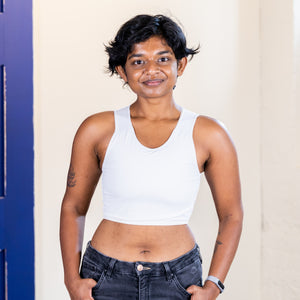
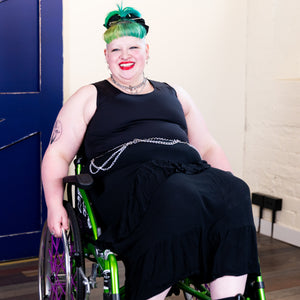

The right fit
Getting the right fit is super important. Your binder needs to be tight in order to do its job, but not be so tight that it you feel restricted or short of breath - if you do, your binder is too tight, you need to go up a size. For Underworks brand, sometimes we recommend to go up or down a size - check the notes beneath the size chart for each binder because different styles have different size guides and fits, even within the same brand. If you need any help or advice with sizing, email us with your chest measurement (measured around the chest across the nipples without clothing). While it can be tempting, don't squeeze into a binder that is too small. Be aware if your body is still developing or changing (particularly for younger people), you may need to change sizes as your body changes.
Measuring for a binder
Measuring for a binder is different to bra or t-shirt sizing. With your arms by your side, without clothing take a snug measurement under your arms around the fullest part of your chest, usually across the nipples. Refer to the size chart of your chosen binder. If applicable, we have included notes recommending to go up or down a size depending on the size. Be sure to check the size chart for each style because sizing of different styles differ, even within the same brand.
A flexible cloth measuring tape is best for getting the correct measurement.
We are always happy to advise with sizing. If you need some help, email us with your chest measurement and the binder/s you are considering.
We understand how important getting the right fit is, so we do accept returns for binders. Check out our Returns Policy.
Putting on a binder
Binders can be tricky to get on - it gets easier with practice, we promise! We recommend:
1. First, fold the bottom half of the binder up before putting the binder on, so the binder doesn't bunch. This is especially helpful for full length binders.
2. Put one arm in armhole, pulling the armhole close to your underarm and over your shoulder.
3. Put your head through the neckhole.
4. Put your other arm through the other armhole.
OR you can put each arm in first then your head.
5. Then pull the folded binder down over your chest and position your chest as described below.
Check out this video on how to put on and take off a binder.
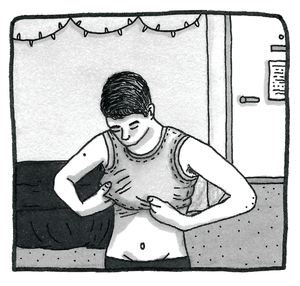
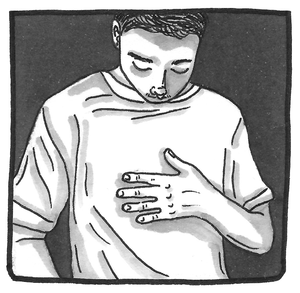
Illustrations by @samuellukeart
Positioning for a flat bind
Once the binder is on, put your hand into the binder through the neck hole and manually position each breast away from the centre of your chest, towards your armpits. If the binder is the right fit, your chest should stay in position. It's important to have multiple chest binders so that you can rotate them and wash them regularly.
Taking off your binder
1. Hold the bottom hem of the binder with your arms crossed.
2. Pull the binder over your head.
Do not take the binder off by pulling the back of the neck over your head as this will stretch it.
Give yourself a break
This is easier said than done, we know, but it is recommended that you don't wear your binder for more than 8 hours a day - it's important to give yourself a break from binding. Never sleep in your binder, and never work out in your binder. We stock a Binding Crop which can be used for exercising, and a Compression Swim Top for swimming.
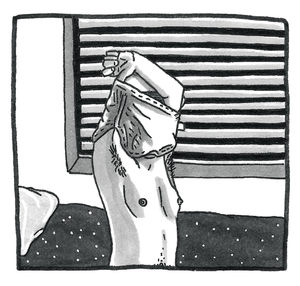
Illustration by @samuellukeart
You can purchase Samuel Luke's art at Sock Drawer Heroes
Keeping your binder clean
As with any undergarment, it's important that you keep your chest binder clean. To extend the life of you binder, we recommend hand-washing, or washing in a delicates bag on a low temperature setting. Air dry flat or on a hanger and do not tumble dry or iron.
Safety
- LISTEN TO YOUR BODY - if you feel any pain, discomfort, dizziness or shortness of breath stop binding. Your binder is too tight.
- Take a break if you need.
- Try not to wear your binder for more than 8 hours a day (it's a good idea to slowly build up to a full day's wear while you get used to it).
- Never sleep in your binder.
- Never wear more than one binder at once.
- Don't exercise in your binder. We have a Binding Crop that is safer for exercising and a Compression Swim Top for swimming in. These have a bit more stretch to allow for movement.
- Keep your binder clean, especially in warm weather.
